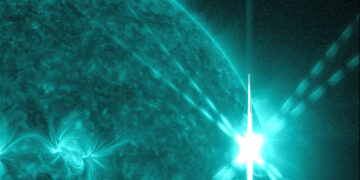On October 1, 2024, the Sun erupted with an intense X7.1-class solar flare, sending a wave of solar particles toward Earth. This flare, one of the strongest of the current solar cycle, could cause dazzling auroras while posing a risk of minor disruptions to communication systems. As we brace for geomagnetic storms over the next few days, let’s explore the significance of this solar event and its impact.
Understanding Solar Flares and Coronal Mass Ejections (CMEs)
Solar flares are among the most dramatic events that occur on the Sun’s surface, releasing immense amounts of energy that can affect space and Earth. These flares result from the complex magnetic fields present around sunspots—cooler, darker regions on the Sun’s surface. When these magnetic fields tangle and realign, they snap and release tremendous energy in the form of light and high-energy particles. Solar flares come in several classes, with the X-class being the most powerful.
The flare that erupted from sunspot AR 3842 on October 1 was categorized as X7.1, putting it in a rare category of ultra-powerful flares. Sunspots are often the origin of solar flares, and this particular sunspot is in a volatile state, making it prone to further activity.
But what makes this solar flare even more remarkable is its accompanying coronal mass ejection (CME). While solar flares are eruptions of light and energy that travel at the speed of light, CMEs are massive bursts of solar material—particles that can take several days to reach Earth. As these particles slam into our planet’s magnetic field, they can trigger geomagnetic storms and cause various disruptions.
The Impact on Earth: What to Expect
Although solar flares and CMEs can sound alarming, the majority of their effects are not harmful to humans on the ground. However, they can cause disturbances in technology, especially those that rely on satellite communication and radio waves. According to NASA’s Space Weather Prediction Center (SWPC), the X7.1 flare may result in strong geomagnetic storms between October 3 and 5, 2024, with levels reaching G3 on the geomagnetic storm scale.
Here’s how solar flares and CMEs could impact daily life:
- Radio Communication Disruptions: The intense burst of energy from the flare can lead to high-frequency radio blackouts on the sunlit side of Earth. These blackouts can affect aviation communication and navigation systems, particularly in polar regions. The Sun’s particles can interfere with global positioning systems (GPS), making it more challenging for high-precision activities such as surveying and oil drilling.
- Power Grid Vulnerability: A geomagnetic storm can induce currents in Earth’s magnetic field, which can overload power grids, potentially causing transformer failures and blackouts. Although power companies now take precautions, such as transformer shielding, strong geomagnetic storms can still pose a risk to our energy infrastructure.
- Satellite Damage: Satellites are particularly vulnerable to space weather, as the increased particle flux can damage their sensitive electronics. In some cases, satellites can be knocked out of service, affecting everything from weather forecasting to telecommunications. The International Space Station (ISS) also needs to take precautions during strong solar activity, such as modifying astronaut activity to minimize radiation exposure.
Aurora Alert: The Bright Side of Solar Activity
While solar flares can cause technical disruptions, they also produce one of the most beautiful natural phenomena visible from Earth: auroras. As the charged particles from the CME collide with Earth’s magnetic field, they get funneled toward the polar regions. There, they interact with gases like oxygen and nitrogen in the upper atmosphere, creating the mesmerizing lights known as the aurora borealis (in the northern hemisphere) and aurora australis (in the southern hemisphere).

The northern lights above Iceland. (Image credit: Chalermkiat Seedokmai via Getty Images)
The recent solar flare is expected to trigger vivid aurora displays over the next few days, visible as far south as Northern Europe and Canada. Aurora enthusiasts are already gearing up for a spectacular light show, with predictions suggesting strong activity, particularly on October 4 and 5.
According to the Kp Index, which measures geomagnetic activity, forecasts indicate that the aurora could reach levels of 6 and 7 on a scale of 0 to 9, making it an ideal time for skywatchers to witness this captivating event. For those in areas with clear skies, the auroras could extend much farther south than usual, offering a rare opportunity to see the lights in locations where they aren’t often visible.
Why This Solar Flare is Significant
The Sun operates on an 11-year activity cycle, with alternating periods of low and high activity. We are currently in Solar Cycle 25, and this flare is a sign that the Sun is approaching the peak of its current cycle, which is expected to occur in 2025.
Solar Cycle 25 has already been characterized by increased solar activity, including several X-class flares and solar storms earlier this year. In fact, May 2024 saw the most powerful flare of the cycle so far, an X8.7, which resulted in stunning aurora displays visible across both hemispheres.
Studying these flares is critical for scientists trying to understand the mechanisms behind solar weather. In addition, predicting the frequency and severity of these flares is essential for preparing Earth’s technological systems against potential disruptions. Satellites, power grids, and even astronauts in space depend on accurate space weather predictions to mitigate the effects of these powerful solar events.
Conclusion: A Glimpse into the Sun’s Power
The October 1, 2024, solar flare offers us more than just the chance to witness a spectacular natural event; it serves as a reminder of the sheer power of the Sun and its influence on our planet. While there may be minor disruptions in communications, power grids, and satellites, the auroras created by this flare promise to be a stunning display of nature’s beauty.
As the Sun enters the peak of its activity cycle, we can expect more of these events in the coming years. By studying and preparing for these solar flares, we are better equipped to protect our technology and deepen our understanding of the star that sustains all life on Earth.
So, whether you’re a science enthusiast tracking space weather or a casual observer hoping to catch a glimpse of the northern lights, this latest solar flare reminds us that the cosmos is full of wonders waiting to be explored and admired.



















